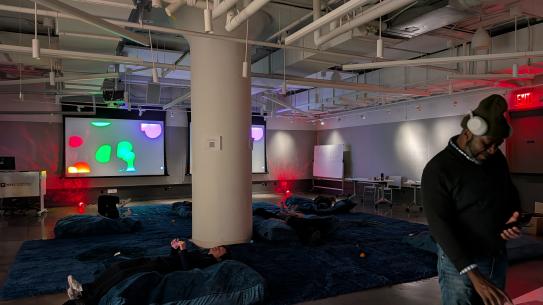Mover and Shaker: PhD Candidate Dustyn Roberts Releases Making Things Move

It’s only her first semester as a PhD candidate in NYU-Poly’s Department of Mechanical and Aerospace Engineering but already Dustyn Roberts has a book out. Published by McGraw-Hill, Making Things Move: DIY Mechanisms for Inventors, Hobbyists, and Artists shipped to booksellers in November, and a launch party in December at Eyebeam Art + Technology Center in Manhattan officially celebrated its release. (Copies are available at NYU-Poly's Bern Dibner Library.)
[GALLERY:4583|left]
The book came about despite Roberts’ dislike of writing. “I didn’t even want to take English in college,” she says. “I never wanted to write.” She instead focused on engineering, receiving a BS in mechanical and biomedical engineering from Carnegie Mellon University and a MS in biomechanics and movement science from the University of Delaware. Her schooling led to a position at Honeybee Robotics, a small firm in New York City, which allowed her to lead field operations of a robotic truck in an Australian mine and supervise the creation of a portable sample manipulation system for lunar operations, among other assignments. After a lay off forced Roberts to leave Honeybee, she founded her own consultancy and developed the course “Mechanisms and Things that Move” for New York University’s Interactive Telecommunications Program, a graduate program that attracts aspiring designers, artists, and communications students.
“People come in not necessarily even knowing what electricity is or what stress and force are,” Roberts says. She’s familiar with that kind of steep learning curve herself, despite her many accomplishments. “I was never the perfect student,” she says. “I had to listen to professors and convince myself I understood engineering in a different way than they taught it.”
That struggle informed Robert’s decision to write Making Things Move. Explaining her motivation, Roberts says, “If I can break engineering down in a different way from how my professors broke it down for me, then maybe I can help someone.”
Her approach to education has resulted in what Roberts describes as a “practical reference book for engineering.” The 350-page paperback is chockfull of helpful photos, illustrations, lists of equipment, and clear explanations of mechanical principles for the non-engineering inclined. “You get enough theory to understand how to choose parts, but it’s based on the practical,” Roberts says. Already she’s receiving enthusiastic reviews about Making Things Move, citing one email from a 45-year-old line worker in Ohio who is taking a robotics class from his local community college. He wrote Roberts to say how he doesn’t yet have an engineering degree — but now he understands how things work.
He was surely helped by the fun, simple experiments that pepper Roberts’ book, which includes challenges such as building a machine that can crack an egg in five steps, designing a cardboard pantograph, and creating a mousetrap-powered car. The last was the featured interactive project at the Eyebeam book launch, which drew children, parents, and other adults. Visitors sat at a large table where feathers, glitter, fishing line, and an assortment of other materials were available for constructing the mousetrap-powered car of their dreams. The activity exposed participants to how energy from a torsion spring can create power, though none may have been able to use those exact words.
Roberts can accept that. “As long as you can relate to the material, engineering isn’t hard,” she says. If the sparkly contraptions that resulted were any indication, it could even be fun.
Find out more about Making Things Move at NYU Tisch’s book party on February 18.



